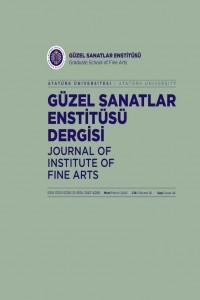"All-Over'dan Devr-i Alem'e"
Dirimsellik, Modülasyon, Soyut Dışavurum
From All-Over to Devr-i Alem
Vitalism, Modulation, Abstract Expressionism,
___
Aubral, F., & Chateau, D. (2000). Figure, figural, ouverture philosophique, L’harmattan.Bernard, E. (1904). Paul Cézanne. L’Occident. Société Cezanne, 32, 17-30. https://www.societecezanne.fr/2016/ 08/04/1904/
Deleuze, G. (1969). Difference et repétition. Presse Univercitaire de France.
Deleuze, G. (1983). L’image-mouvement. Minuit.
Deleuze, G. (2009). Duyumsamanın mantığı. (C. Batukan ve E. Erbay, Çev.). Norgunk Yayıncılık.
Erdinç, Z. (2010). Devr-i Âlem [Metal Konstrüksiyon]. Zekeriya Erdinç kişisel arşivi.
Erdinç, Z. (2017). Devr-i Âlem [Fotoğraf]. Zekeriya Erdinç kişisel arşivi.
Erdinç, Z. (2019). Devr-i Âlem [İp Üzerine Sprey Boya]. Zekeriya Erdinç kişisel arşivi.
Fried, M. (1976). Trois peintres Américains. Revue d’Esthétique, 1, 240-247. http://www.louismarin.fr/wp-content/uploads/sites/39/2019/05/Esthetique2_compressed.pdf
Gaffiot, F. (1934). Dictionnaire Latin Français. Hachette.
Kandinsky, W. (2009). Du spirituel dans l’art. Denöel Collections Folio/Essais.
Klée, P. (2010). La theorie de l’art moderne. Gallimard.
Krauss, R. (1978). L’atelier de Jackson Pollock. Macula.
Krauss, R. 1998). Les derniers modernes, histoire de l’art en occident. Flammarion.
Lefranc, D. (1950). Jackson Pollock at work in Long Island [Fotoğraf]. https://www.theguardian.com/books/2012 /feb/26/jackson-pollock-evelyn-toynton-review
Lynton, N. (1982). Modern sanatın öyküsü (C. Çapan, Çev.). Remzi Kitapevi Yayınları.
Maldiney, H. (2012). Regard, parole, espace. Du Cerf.
Méredieu, D. F. (1994). Histoire matérielle et immatérielle de l’art moderne. Bordas Mame.
Michaud, Y. (2003). L’art à l’état gazeux: Essai sur le triomphe de l’esthétique. Stock.
Payant, R. (1979). La libération de la peinture. Musée d’Art Contemporain.
Rosenberg, H. (1962). Les peintres d’action Américains. Les éditions de Minuit.
Worringer, W. (1967). L’art Gothique (D. Decourdemande, Çev.). Gallimard.
- ISSN: 1300-9206
- Yayın Aralığı: Aylık
- Yayıncı: Atatürk Üniversitesi
Üç Aşk Konulu Mesneviden Minyatürler ve Feraye Türküsü Minyatürü
Bilecik Belediyesi Yaşayan Şehir Müzesi ve Yaşama Katkıları
Serap BUYURGAN, Gizem Büke ÖZTÜRK
Van Hüsrev Paşa Külliyesi Mimari Süsleme ve Onarımı
Afrika Sanatının Koruyucu İşlevi Ekseninde Nick Cave’in Sanat Pratiği
Mimari ve Plastik Sanat Akımlarının Gotik ve Rönesans Dönem Koro Müziğine Yansımaları
Thomas Hobbes’un İnsan Felsefesi Bağlamında The Platform (2019) Filmi Üzerine Bir Analiz
